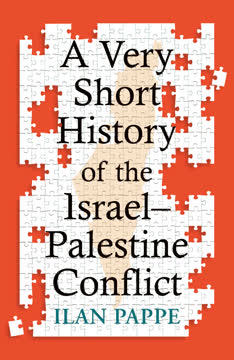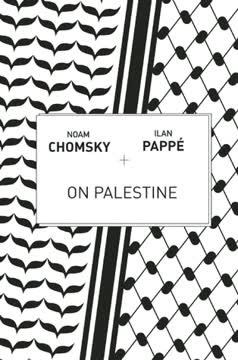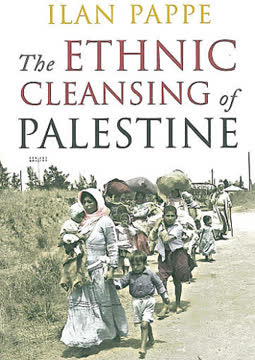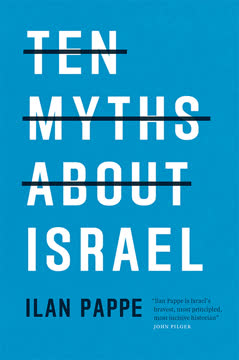Key Takeaways
1. The Genesis of Conflict: A Settler-Colonial Project
Even at this stage, Zionist thinkers did not simply see the movement towards Palestine as a desperate escape from antisemitism in Europe. They saw it as laying the groundwork for taking over Palestine.
Challenging myths. The conflict did not begin on 7 October 2023, nor was Palestine "a land without a people." Its roots lie in the late nineteenth century with the rise of Zionism, a movement that, while partly a response to European antisemitism, also harbored clear intentions of taking over Palestine. Early Zionist leaders like Theodor Herzl openly discussed "spiriting away" the "penniless population" (Palestinians) to neighboring countries, revealing a foundational intent to displace the indigenous inhabitants.
Palestinian identity. At the turn of the 20th century, Palestine was a vibrant part of the Ottoman Empire, home to half a million people, predominantly Muslims, with significant Christian and Jewish minorities. A distinct Palestinian Arab identity was flourishing, marked by a shared Arabic dialect, customs, and a cultural renaissance, actively participating in broader pan-Arab nationalist sentiments against Ottoman Turkish imposition. This established society directly contradicted the Zionist narrative of an empty land.
Settler-colonial nature. By the mid-1920s, Zionism evolved from a movement seeking a safe haven to a clear settler-colonial project. Unlike classical colonialism, which aims to rule native populations, settler colonialism seeks to replace them entirely. This "logic of elimination," as described by scholar Patrick Wolfe, necessitated the dehumanization of Palestinians, portraying them as "savages" or "nomads" to justify their dispossession and the myth of "making the desert bloom."
2. British Betrayal: Paving the Way for Dispossession
On 2 November 1917, the British government made the Balfour Declaration, promising to make Palestine a ‘national home for the Jewish people’, while protecting the civil and religious rights of ‘existing non-Jewish communities’ in Palestine, i.e. the indigenous majority.
Contradictory promises. During World War I, Britain made conflicting promises: to the Hashemites, an independent Arab state including Palestine, and to the Zionist movement, a "national home for the Jewish people" via the Balfour Declaration. This declaration, driven by British imperial interests (securing the Suez Canal) and a mix of Christian Zionism and antisemitism, disregarded the aspirations of Palestine's indigenous majority. Arthur Balfour himself, as prime minister, had previously pushed for immigration restrictions against East European Jews in Britain.
Mandate and suppression. After the Ottoman Empire's collapse, the League of Nations granted Britain a mandate over Palestine in 1922, echoing the Balfour Declaration and directing Britain to "facilitate Jewish immigration." Unlike other mandated territories that gained independence, Palestine was treated as an exception. Britain appointed a high commissioner but failed to establish a representative government due to Palestinian rejection of any council tied to the Balfour Declaration.
Zionist proto-state. During the Mandate, Britain tacitly allowed the Zionist movement to build a parallel proto-state infrastructure, including:
- Its own educational system (Technion, Hebrew University)
- Industries and economic institutions
- A paramilitary force (Haganah)
- A revived Hebrew language and ethnonational identity
Meanwhile, the Palestinian majority was treated as colonial subjects, denied self-governance, and subjected to an inferior British-imposed administration, effectively hindering their national development.
3. The Nakba: Palestine's Catastrophe of Ethnic Cleansing
On 10 March 1948, David Ben-Gurion and a small group of military generals in the Haganah’s intelligence unit produced what would go down in history as Plan Dalet, or Plan D.
UN Partition and its aftermath. On 29 November 1947, the UN General Assembly, under significant US pressure, voted for Resolution 181, partitioning Palestine. It allocated 56% of the land to a Jewish state (with nearly equal numbers of Jews and Palestinians) and 43% to a Palestinian state, with Jerusalem as an international enclave. This decision, celebrated by Zionists and seen as the start of the Nakba by Palestinians, legitimized the creation of a Jewish state but ignored the democratic rights of the indigenous majority.
Plan Dalet's execution. With British departure imminent, the Zionist leadership implemented Plan Dalet, a systematic strategy to remove as many Palestinians as possible to ensure a Jewish majority. This involved:
- Surrounding villages from three sides, leaving one open for flight.
- Destroying villages and planting explosives to prevent return.
- Targeting men (18-48) for arrest or execution.
- Utilizing detailed intelligence files on each Palestinian village.
Mass expulsions and urbicide. Between March and May 1948, Zionist forces ethnically cleansed urban centers like Haifa, Jaffa, Acre, and Safed, along with their surrounding villages. The Deir Yassin massacre on 9 April 1948, where over a hundred villagers were killed by Irgun and Stern Gang militants, served as a brutal warning, accelerating Palestinian flight. By the end of 1948, half of Palestine's Arab population (around 750,000 people) had been expelled, over 500 villages destroyed, and most towns demolished, replaced by Jewish settlements and European pine trees.
4. Post-1948: Ongoing Dispossession and Early Resistance
Israel understood the silence and inaction during the Nakba as carte blanche to continue to use ethnic cleansing as a means of establishing and fortifying the Israeli state and its national security.
Impunity and ongoing Nakba. Despite detailed reports from journalists and international bodies on the atrocities of 1948, Israel faced no condemnation for its actions. This perceived international immunity emboldened Israel to continue ethnic cleansing as a state-building strategy, a process Palestinians call "al-Nakba al-Mustamirra" (the Ongoing Nakba). This reinforced the settler-colonial structure, where dispossession is a continuous process.
Military rule and repression. Palestinians who remained within Israel's new borders (the '48 Arabs) were placed under military rule until 1966, a regime that mirrored British emergency regulations. This allowed for:
- Expulsions, detentions without trial, and arbitrary violence.
- Imposition of curfews, often without notice, leading to massacres like Kafr Qasim in 1956, where 49 villagers were killed for violating an unannounced curfew.
- Ransacking of businesses and homes.
Emergence of resistance. In the West Bank, annexed by Jordan, and especially in the Gaza Strip, which became the world's largest refugee camp, Palestinian national identity reawakened. Refugees, initially attempting to retrieve belongings from their former villages, formed guerrilla units called Fedayeen ("those ready to sacrifice themselves"). Israel retaliated brutally, notably with Unit 101 under Ariel Sharon, which perpetrated massacres like Qibya in 1953, killing 69 people and destroying 45 houses. This period also saw the informal organization of Fatah in 1957 and the establishment of the PLO in 1964.
5. 1967: The Making of the "Two Biggest Prisons"
Within six days the Israeli army created a mini-empire, occupying the West Bank, the Gaza Strip, the Sinai Peninsula and the Golan Heights.
Greater Israel's ambition. Israel's "alone" myth often obscures its expansionist ambitions. Despite Egyptian President Nasser's willingness to negotiate in the 1950s, Israel's participation in the 1956 Suez Crisis fueled Arab fears of further aggression. By the mid-1960s, a "Greater Israel" lobby within the Israeli government, supported by religious Zionists, actively sought to conquer all of historical Palestine. Pre-war planning, like the Shaham Plan (1963-64), detailed how to administer the West Bank and Gaza under military rule.
The Six-Day War. In June 1967, Israel launched a coordinated attack, destroying Arab air forces and swiftly occupying the West Bank, Gaza Strip, Sinai Peninsula, and Golan Heights. This war completed Israel's control over all of historical Palestine. In the Golan Heights, nearly a hundred villages were ethnically cleansed, expelling inhabitants to Syria, demonstrating the continuity of 1948 methods.
New model of occupation. The post-1967 Israeli government decided against mass expulsions on the scale of 1948, instead opting to let most Palestinians stay but denying them Israeli citizenship. This led to the implementation of military emergency regulations, transforming the West Bank and Gaza into de facto prisons. Key decisions included:
- Expelling a smaller number of Palestinians (around 300,000).
- Refusing Israeli citizenship to Palestinians in occupied territories.
- Maintaining direct or indirect control over these areas, despite any future "peace process."
This strategy laid the groundwork for decades of systemic oppression, violating basic civil and human rights through a pervasive system of policing and control.
6. The Illusion of Peace: Oslo's Unfulfilled Promises
The Israelis implied, although they refused to explicitly commit to it, that the Palestinian area that would be governed autonomously according to the Oslo agreements could become a state.
Madrid's failure. The 1991 Madrid Peace Conference, convened after the First Gulf War, aimed to resolve the Palestine question. Despite meticulous preparations by Palestinian delegates for a genuine two-state solution, their ideas were rejected by Israel. The PLO, isolated after supporting Saddam Hussein and facing the collapse of the USSR, engaged in secret talks with Israel, bypassing the official Palestinian delegation.
Oslo Accords: A dictated peace. The Oslo I Accord (1993), brokered by Norway, saw a disempowered PLO accept Israeli terms. It created the Palestinian Authority (PA) to manage domestic affairs in limited areas (Area A: 18% of West Bank), requiring collaboration with Israeli security services. Yasser Arafat became PA president, but the agreement split the Palestinian resistance, with Islamist groups like Hamas and Palestinian Islamic Jihad rejecting it.
Deepening occupation. Oslo II (1995) further solidified a fragmented reality:
- Area A: Palestinian civil control, Israeli security control (18% of West Bank).
- Area B: Joint Israeli-Palestinian control (22% of West Bank).
- Area C: Full Israeli control, including most settlements (60% of West Bank).
- Gaza Strip: Similar to Area B, later fenced off.
The accords failed to address core issues like Jerusalem, settlements, and refugee return, leading to increased settler violence, Palestinian resistance, and the assassination of Israeli Prime Minister Yitzhak Rabin in 1995. The subsequent Netanyahu government intensified oppressive measures, including hundreds of checkpoints and the "Judaisation" of Jerusalem.
7. Systemic Apartheid: Legalizing Discrimination
Judaisation requires the perpetual subordination of Palestinians, regardless of where they are in historical Palestine.
Legalizing discrimination. In the 21st century, Israel intensified its Judaisation policies across all of historical Palestine, solidifying a system of apartheid. Key legislation included:
- Nationality and Entry into Israel Law (2003): Barred Palestinians from West Bank/Gaza from gaining citizenship through marriage to Israeli citizens.
- Nakba Law (2011): Cut funding for institutions commemorating the Nakba.
- Jewish Nation-State Basic Law (2018): Downgraded Arabic, declared Jerusalem as Israel's capital, and promoted settlement expansion, prioritizing Jewish citizens.
Land and displacement. These laws, combined with policies like the Jewish National Fund's charter (disallowing land transactions with non-Jews), effectively bar Palestinian citizens (over 20% of Israel's population) from buying land or developing their communities. In the Naqab desert, Bedouin communities face aggressive Judaisation, with "unrecognized villages" repeatedly demolished, demonstrating a continuous policy of displacement and control.
Failed international efforts. Despite the Arab League's 2002 Arab Peace Initiative (offering full recognition for a genuine two-state solution based on 1967 borders, even omitting refugee return), Israel rejected it, supported by the US. The Quartet (US, UN, EU, Russia) also failed, viewing Palestinian resistance as the main obstacle rather than Israeli expansionism. Sharon's 2005 "disengagement" from Gaza, removing 8,000 settlers, was a self-serving move to "prove" West Bank withdrawal was impossible and to turn Gaza into a contained "prison" for Hamas.
8. 7 October 2023: A Consequence of Unaddressed History
The Hamas fighters who stormed into Israel on 7 October were largely young people who learned the language of violence from the bombs that Israel dropped on them.
A predictable eruption. The 7 October 2023 attack by Hamas, while condemned, cannot be understood outside the context of decades of occupation, siege, and unaddressed grievances. UN Secretary-General Antonio Guterres's mild statement acknowledging "56 years of suffocating occupation" was met with Israeli outrage and accusations of antisemitism, highlighting Israel's efforts to censor any questioning of its policies.
Gaza's plight. Most Gazans are refugees from the 1948 ethnic cleansing, living in what was created as a "holding pen" for displaced Palestinians. Since 1967, Gaza, like the West Bank, has been under occupation, and since 2007, under a severe siege, depriving inhabitants of essentials like water and electricity. Half of Gaza's population is under 21, knowing only this reality of siege and bombardments.
Cycles of violence and resistance. The frustration from ongoing persecution, including:
- Thousands of political prisoners.
- Provocations regarding holy sites (Haram al-Sharif/Al-Aqsa Mosque).
- Routine home demolitions, land expropriations, and army abuse.
- Four major Israeli attacks on Gaza since 2007.
These factors fueled the First and Second Intifadas and contributed to the rise of Islamist groups like Hamas, who gained popularity after secular movements failed to end subjugation. The 7 October attack, therefore, represents a violent eruption stemming from a long history of trauma and a lack of political resolution.
9. The Path Forward: Recognizing Anticolonial Struggle
It is time to recognise the Palestinian national movement as an anticolonialist movement.
Refuting foundational myths. This history refutes the myth of Palestine as an empty land and the justification of colonization based on ancient religious texts. It demonstrates that a Jewish state was built on Palestinian land due to British imperial interests, violating promises of self-determination to Palestinians and making Britain complicit in ethnic cleansing.
Zionism as settler-colonialism. Understanding Zionism as a settler-colonial movement is crucial. It explains the early discussions of "transferring" Palestinians and the continuous ethnic cleansing from the 1920s to the present day, culminating in the extreme violence seen in 2023. This framework highlights the inherent drive to remove or subordinate the native population.
International failure and complicity. The international community, particularly the US and its European allies, has consistently failed as honest brokers. Their "peace efforts" often ignored Palestinian suffering and rights, effectively shielding Israeli expansionism. The portrayal of the Palestinian anticolonial struggle as mere terrorism, while other anticolonial movements were supported, has perpetuated bloodshed. Recognizing the Palestinian national movement as a legitimate anticolonial struggle is essential for any hope of peace and justice.
Last updated:
Review Summary
A Very Short History of the Israel-Palestine Conflict receives mostly positive reviews for its concise yet comprehensive overview of the conflict's history. Readers appreciate its accessible writing and informative content, though some criticize it as biased toward Palestinians. Many find it eye-opening and essential reading for understanding the current situation. Critics argue it lacks balance and omits key historical context. Overall, reviewers recommend it as a starting point for learning about the Israel-Palestine conflict, while acknowledging its perspective.
Similar Books
Download PDF
Download EPUB
.epub digital book format is ideal for reading ebooks on phones, tablets, and e-readers.








